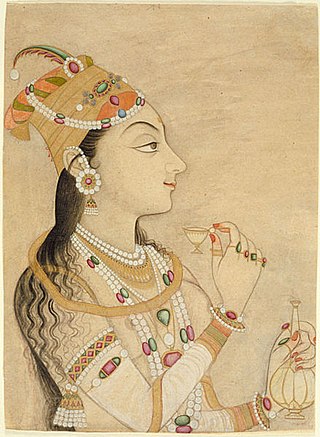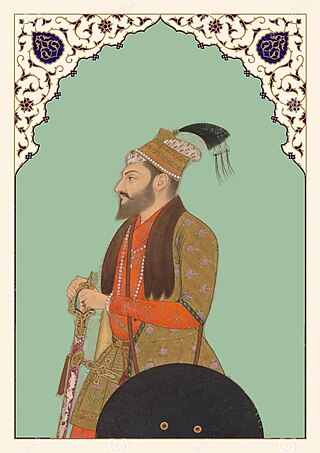
Mirza Shahab-ud-Din Muhammad Khurram, commonly called Shah Jahan I, also called Shah Jahan the Magnificent, was Emperor of Hindustan from 1628 until his deposition in 1658. As the fifth Mughal emperor, his reign marked the zenith of Mughal architectural and cultural achievements.

The Peacock Throne was the imperial throne of Hindustan. The throne is named after the dancing peacocks at its rear and was the seat of the Mughal emperors of India from 1635 to 1739. It was commissioned in the early 17th century by Emperor Shah Jahan and was located in the Diwan-i-Khas in the Red Fort of Delhi. The original throne was taken as a war trophy by Nader Shah, Shah of Iran in 1739 after his invasion of India. Its replacement disappeared during or soon after the Indian Rebellion of 1857.

Mumtaz Mahal was the empress consort of Mughal Empire from 1628 to 1631 as the chief consort of the fifth Mughal emperor, Shah Jahan. The Taj Mahal in Agra, often cited as one of the Wonders of the World, was commissioned by her husband to act as her tomb.

Jahanara Begum was a princess of the Mughal Empire. She was the second and the eldest surviving child of Mughal Emperor Shah Jahan and Mumtaz Mahal.

Nur Jahan, born Mehr-un-Nissa was the twentieth wife and chief consort of the Mughal emperor Jahangir.

Muzaffar al-Din Jahan Shah ibn Yusuf or Abu al-Muzaffar Jahan Shah was the leader of the Qara Qoyunlu Oghuz Turkic tribal confederacy in Azerbaijan and Arran who reigned c. 1438 – 1467. During his reign he managed to expand the Qara Qoyunlu's territory to its largest extent, including Eastern Anatolia, most of present-day Iraq, central Iran, and even eventually Kerman. He also conquered neighbouring states. He was one of the greatest rulers of the Qara Qoyunlu. He was also allegedly fond of drinking and entertainment. During his reign Jahan Shah had the Gökmedrese and Muzafferiye theological schools constructed in his capital city Tabriz.

Mirza Muhammad Murad Bakhsh was a Mughal prince and the youngest surviving son of Mughal Emperor Shah Jahan and Empress Mumtaz Mahal. He was the Subahdar of Balkh, till he was replaced by his elder brother Aurangzeb in the year 1647.

Shah Jahan II, born Mirza Rafi-ud-Daulah, was briefly the twelfth Mughal emperor in 1719.

Roshanara Begum ; 3 September 1617 – 11 September 1671) was a Mughal princess and the third daughter of Emperor Shah Jahan and his wife, Mumtaz Mahal. Roshanara was a brilliant woman and a talented poet. She was a partisan of her younger brother, Aurangzeb, and supported him during the war of succession which took place after Shah Jahan's illness in 1657. After Aurangzeb's accession to the throne in 1658, Roshanara was given the title of Padshah Begum by her brother displacing her sister and rival Jahanara Begum. This made her the de-facto First Lady of the Mughal Empire, and a powerful political figure. However, after the death of Shah Jahan, Jahanara succeeded in regaining her title of Padshah Begum, by replacing Roshanara. Towards the end of her life, Roshanara was sidelined in Aurangzeb’s court.

Mirza Ghiyas Beg, also known by his title of I'timad-ud-Daulah, was an important official in the Mughal Empire, whose children served as wives, mothers, and generals of the Mughal emperors.

Shahryar Mirza was the fifth and youngest son of the Mughal emperor Jahangir. At the end of Jahangir's life and after his death, Shahryar made an attempt to become emperor, planning, supported and conspiracy by his one in influence and all-powerful stepmother Nur Jahan, who was also his mother-in-law. The succession was contested, though Shahryar exercised power, based in Lahore, from 7 November 1627 to 19 January 1628, but like his father, he allowed Nur Jahan to run the affairs and consolidate his reign, but she did not succeed, and he was defeated and was killed at the orders of his brother Khurram, better known as Shah Jahan once he took the throne. Shahryar would have been the fifth Mughal Emperor, but is usually not counted in the list of Mughal Emperors.

Muhammad Saleh Kamboh Lahori was a noted Punjabi Muslim calligraphist and official biographer of Emperor Shah Jahan and the teacher of Mughal Emperor Aurangzeb. Though a widely read person, little is known of the life of Muhammad Saleh Kamboh other than the works he composed. He was son of Mir Abdu-lla, Mushkin Kalam, whose title shows him to also have been a fine writer. He is believed to be younger brother of Inayat-Allah Kamboh and worked as a Shahi Dewan (Minister) with the governor of Lahore. He held the title of Sipahsalar.

Mazar-e-Shura is a cemetery on a small hill by the main road in Dalgate, an area of Srinagar, Jammu and Kashmir in India. Founded in the reign of the Mughul emperor Akbar the Great, it was built in a scenic location on the banks of the Dal Lake as a cemetery for eminent poets. Historical records show that there were five poets and men of letters buried in the cemetery, all natives of Iran who emigrated to India and were associated with the Mughal court. Only three tombstones are now visible as the place is neglected, overrun by weeds and littered with rubbish. One of the tombstones bears an inscription that is only partially legible.

Shah Niyaz Ahmad (1742-1834) was a Sufi, poet and author from India.
Qasim Khan Juvayni was a Mughal general and nobleman of the court of Mughal emperors Jahangir and Shah Jahan. He also served as the Subahdar of Bengal, succeeding Fidai Khan, from 1628 to 1631. He is most notable for the capture of Hugli off the Portuguese firingis.
Kalim Kashani (1581/1585–1651) was one of the leading Persian poets of the 17th century.

Abu'l-Hasan entitled by the Mughal emperor Jahangir as Asaf Khan, was the Grand Vizier of the fifth Mughal emperor Shah Jahan. He previously served as the vakil of Jahangir. Asaf Khan is perhaps best known for being the father of Arjumand Banu Begum, the chief consort of Shah Jahan and the older brother of Empress Nur Jahan, and the maternal grandfather of mughal emperor Aurangzeb.
Izz-un-Nissa Begum was the third wife of the Mughal emperor Shah Jahan. She is popularly known by the title, Akbarabadi Mahal, and commissioned the Akbarabadi Mosque in Shahjahanabad. Less commonly, she is also referred to as Sirhindi Begum.
Khvajeh Mohammad-Sharif was a Persian statesman, who occupied the post of vizier of several Safavid provinces. He was also a poet, who wrote under the pen name Hejri (هجری).
Mirza Zulqarnain or Mirza Zul-Qarnain was a diwan and faujdar of Armenian descent in the court of the Mughal Empire.














